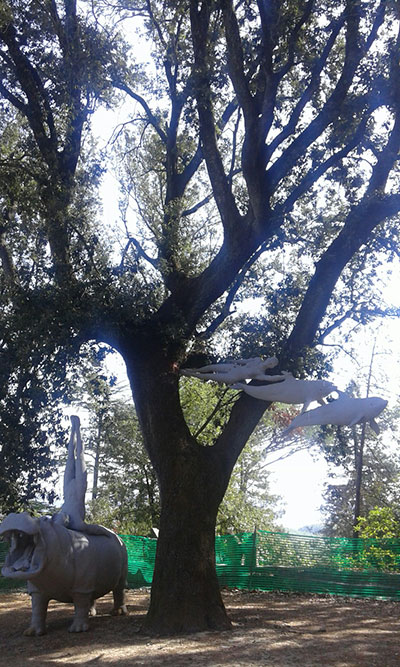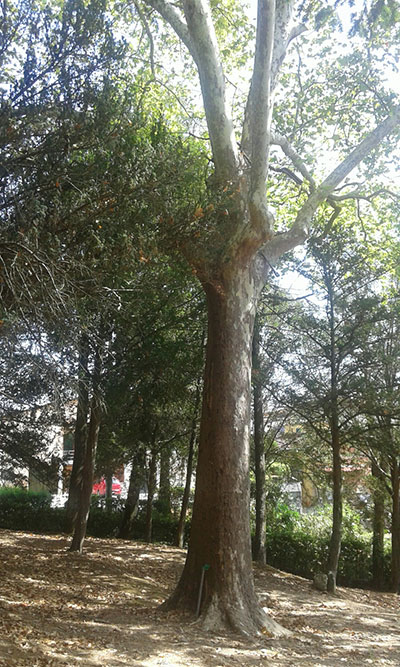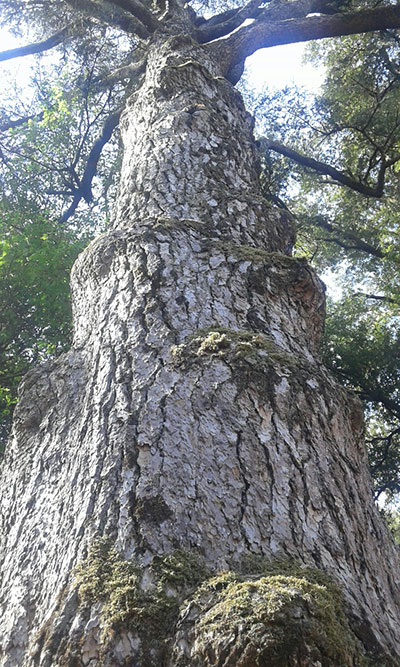11 Feb2018
Written by aeb4mvb. Posted in Museums sheets

Holm oak (Quercus ilex L., 1753) also known as Holly Oak and Evergreen oak tree, is a tree species belonging to the family of Fagaceae, native to the Mediterranean region. Holm oak is a very long-lived tree that can reach up to 100 years of age.
An evergreen tree of large size, attaining in favorable places a height of 20–25 meters, and developing in open situations a huge head of densely leafy branches as much across.
They have grey and smooth bark when young, becoming darker, almost blackish and fissured with age, opening up square in shape cracks in all directions of the trunk.
The young branches are grey and pubescent, but after a while they became greenish grey and glabrous. Buds are small, tomentose and rounded with only few perule.
They have a deep-rooting, tap-rooting and a fine root structure that develop already in the first few years of life and their roots can deeply penetrate into the ground for several meters. This allows them to withstand drought (trees draw water from the ground), but entails problems in transplantation, operation not appreciated by this species. The lateral roots may also be very robust and they often grow root suckers.
11 Feb2018
Written by aeb4mvb. Posted in Museums sheets

Taxus (Taxus baccata L., 1753) is a genus of small coniferous trees in the yew family Taxaceae, it is widely used in landscaping and ornamental horticulture or it is used for formal hedges and topiary. Taxus is also known as the “tree of death”.
It is a small to medium-sized evergreen tree, the bark is thin, scaly brown, coming off in small flakes aligned with the stem. They are relatively slow-growing and can be very long-lived, and reach heights of 10–20 meters, with irregular globose top and low-positioned branches.
They have dark-green leaves, 3 cm long, arranged spirally on the stem, but with the leaf bases twisted to align the leaves in two flat rows either side of the stem. The leaves are poisonous.
11 Feb2018
Written by aeb4mvb. Posted in Museums sheets

Atlas Cedar (Cedrus atlantica), (Stephan Endlicher – G. Manetti, ex Elie-Abel Carrière 1855), is a tree species belonging to the family of Pinaceae. It is named after the Atlas Mountains in northwest Africa, where you can find the tree in its natural habitat, it is also called silver cedar for its silver-blue needles.
When cultivated they reach 30 meters of height, whereas they can reach even 45 meters of height in spontaneous conditions. Atlas Cedaer is a conical, wide pyramidal tree that tend to expand with age.
The trunk is straight, cylindrical. The greyish brown bark is fissured and cracked.
10 Feb2018
Written by aeb4mvb. Posted in Guided tours
Objective
- Stimulate fine handling and creativity
- Know the handling natural material
- Know the shape
- Approach to three-dimension manipulation.
Development
The objective of the proposal is the achievement of the creativity autonomy in the fine handling. During the five meetings, children will be encouraged to handle materials of natural origins. The material used will be clay, salt dough. Starting from the classic production of the salt dough, will be handle the end product and create a work with the clay.
Meeting 1 – Dough
Children will be guided towards the transformation of three elements such us flour, water and salt in the ‘modeling salt dough’; material that probably is already well-known as end products. The aim of the meeting is to transformed and experiment dough. Free manipulation.
Meeting 2 – Shapes
During the workshop, children will handle the dough in a guide manner. With the help of recognizable and simple shapes, they can realize the material ductility and the various possibility in handling. Guided manipulation in the shapes creation.
Meeting 3 – Clay
During the workshop will be presented a new material: the clay. Will be provided experimental examples with the help of natural clay clods (it would be possible, to be agreed, to search clayey soils in the countryside). Free handling, study of the differences between clay and dough.
Meeting 4 – Pushing
Even if banal, pulling clay process has specific rules. Children will experience different ways to obtain a workable dough layer. Through the use of rolling pins and splints, children will rolling one or more layers to use as bases of work.
Meeting 5 – Dimension
Observation and study of three-dimensional shapes/forms and production of simple forms already know by children. Possible links with other subject areas: Art, Nature, Science, Nutrition.
Target
Every meeting takes about 50-60 minutes according to the age of the students. All materials are included in the offer. The itinerary is organized and designated for children of I-II-III grades of nursery school.
nursery school
10 Feb2018
Written by aeb4mvb. Posted in Guided tours
Objective
- Knows natural colours
- Recognize colours
- Acquire autonomy on pictorial gesture
- Stimulate fine manual skill and creativity
- Demolition of the technical stereotype related to classic standardized industrial colours
Development
The aim of the itinerary, divided into five meetings, is to get the children closer to natural colours. Plants, vegetables, food and different types of grounds will be used to create genuine tools for painting, experienced directly by children at every meeting. The aim of the itinerary is to get the children closer to nature and science trough the artistic approach.
Meeting 1 – The Earth
Will be shown to the children various type of earth per colour and consistency During the meeting will be increased the visual and tactile knowledge (also with the use of magnifying lenses). The earth will be powder and, by the addition of water, will be turn into mineral colours.
Meeting 2 – Plants
Painting on paper will be displayed to children several plants that can be used to create different colours. Plants are observed and transformed into colours indifferent ways. Will be shown the plants previously transformed (via boiling and cooking). Painting on hard material (e.g. wood).
Meeting 3 – Vegetables/fruits
Will be showed to children different types of vegetables, used directly as coloring already made. With vegetables is possible to experiment not only coloring process, but also forms and molds. Painting on paper and carton.
Meeting 4 – Food
Will be showed to children how the variety of food can be used as if they were mineral colours. They will observe, touch and study the consistency and texture by the magnifying lens. Painting on paper and porous cardboard.
IMeeting 5 – Coal
Observation of coal pieces, knowledge of the material, study and manipulation of them. Connection between coal/wood with experimental example. Improving drawing techniques based on the use of charcoal. Possible links with other subject areas: Art, Nature, Science, Nutrition.
Target
Every meeting takes about 50-60 minutes according to the age of the students. All materials are included in the offer. The itinerary is organized and designated for children of I-II-III grades of nursery school.
nursery school







